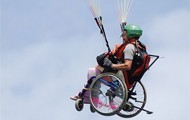Practical problems found during the process of revising Regulations on the Education of the Disabled
【Background Information】 Since 2009, the State Council of the People's Republic of China has listed the agenda to revise Regulations on the Education of the Disabled (Revised Draft) (hereinafter referred to as Draft) and entrusted staff from the Department of Policies and Laws, Office of Legislative Affairs, and the Ministry of Education to revise it. After three years of taking shape, the draft for examination of the Revised Draft was formed. At the beginning of 2013, the Revised Draft was delivered to the Office of Legislative Affairs of State Council by the Ministry of Education’s Department of Policies and Laws. Public opinions were solicited between February 25th and March 25th.
The revision of Regulations on the Education of the Disabled has entered the final stage of soliciting opinions. As a person with low vision since childhood, I am a non-mainstream person wandering through the mainstream educational system. I always focus on the education of persons with low vision and have come across many examples since the revision of the regulations. Especially on March 8th, One Plus One - the department that I belong to, One Foundation, ZhiCheng Public Interest, and many other organizations united to hold a seminar to solicit opinions publicly. Over 80 people attended the seminar, many of which were disable individuals and families with different education backgrounds. During the seminar, we raised a lot of practical problems and compiled and submitted revisions for opinions for the Draft in accordance with procedural requirements.
Through my own experience and the problems listed by others, I would like to talk about some practical problems that we may experience when educating people with low vision.
Serious segregation
Compared with the previous version of the Regulations on the Education of the Disabled (1994), the Draft highlights and emphasizes integrating structure and content in education. Through this point, we can see that current practices of segregation are still very common in the education of disabled people. For a long period of time, this phenomenon is inseparable from the idea, of treating people with a disability as defective and in need of extra supervision with special requirements. Finally, disabled people are unfairly judged based on the above, segregated, and rejected by mainstream.
I. Special needs
It is, no doubt, worthy to highlight the tremendous advance toward integrated education in the Draft. However, wording in the Draft still tends toward segregation, describing people with a disability and their needs as special and particular, especially in the most representative Article 23. The above-mentioned practice is very common in daily expressions about people with a disability. Individuals with disabilities always tend to be viewed as extra burdens and in need of segregation. More seriously, the particularity is overly stressed, which may result in the segregation between people with disabilities and the social mainstream. This situation runs counter to eliminating the misunderstandings surrounding individuals with disabilities in society.
II. Education of disabled people is second class
Integrated education includes but is not limited to attending regular classes and special education class. The two education systems are not advanced enough. While there are only two types of integrated education at the present stage, integrated education has a deeper connotation and form. But from the expression of the Draft, we can see that learning in a regular classroom and in a special educational classroom, a so-called mixing of the class, still remains dominated by the present educational system. Both in concept and practice, lawmakers and practitioners alike fail to balance education and demands. Ultimately, education of the disabled has become second class.
III. Presumptions about defects
Disability should be treated as a systematic obstacle, not an individual defect. In every aspect of real life, people with a disability can often hear expressions like capability failure, physical defect, and so on. This issue is also reflected incisively and vividly in the Draft. Disability kind and ability to accept forms the basis to establish education types. It's really a joke that there's an expression that disabled children who can't receive ordinary education should appear in articles. There are only schools that don't meet educational standards. And there is no one who won’t receive that kind of education. Shouldn't the expression be the ordinary school doesn't meet the standards of satisfying the disabled?
IV. Higher education difficulties still exist
In reality, because of obstructions in the college entrance examination, unreasonable physical examination standards, single options of majors and other reasons, many persons with low vision have difficulties attending ordinary universities. The Draft still includes physical qualifications in admission qualifications, which doesn't conform to the basic principles of promoting equal education. It remains relatively conservative regarding expanding major selection for disabled people. Around the world, disabled people should have the right to choose majors freely instead of choosing from limited choices provided by schools.
V. Legislation by department
Because conceptualization is a step forward, the final attitudes and behaviors of people are related to concepts. Therefore, the above-mentioned problems most involve an aspect of conceptualization. We need to be pragmatic in the details. But nowadays the legislative model is legislation by department, which inevitably has limitations. For example, the Draft is a very flexible legislation. Though many times the words should and forbid are firmly used, it may be very difficult to ensure implementation of such articles in practice.
Many people admire that disabled people have certain rights in some countries. However, they ignore the pursuit and insistence by so many disabled people that the education of disabled people, the realization of real integration and equality relies on not only legislation, but also the attention and participation of every disabled person.






